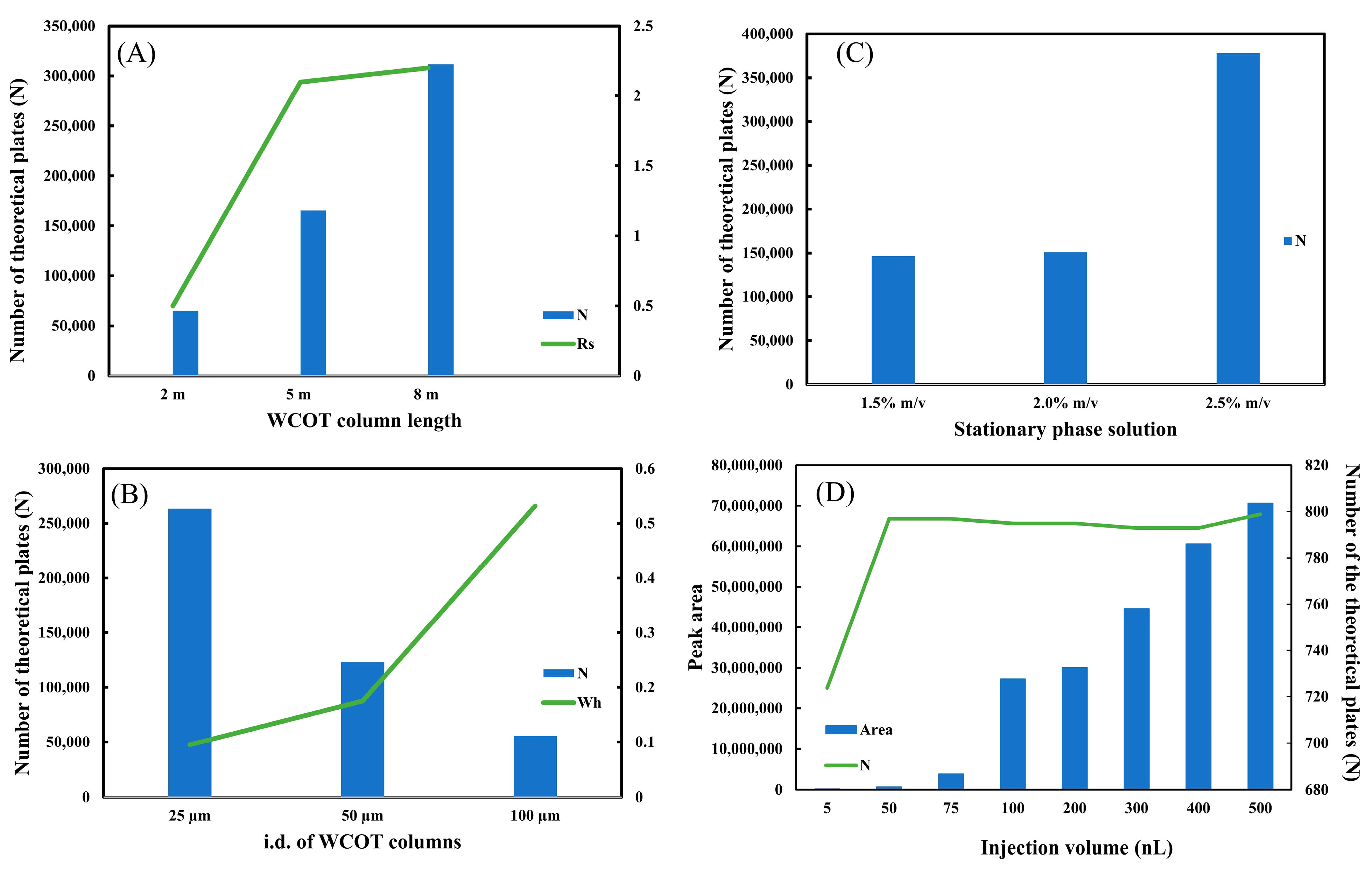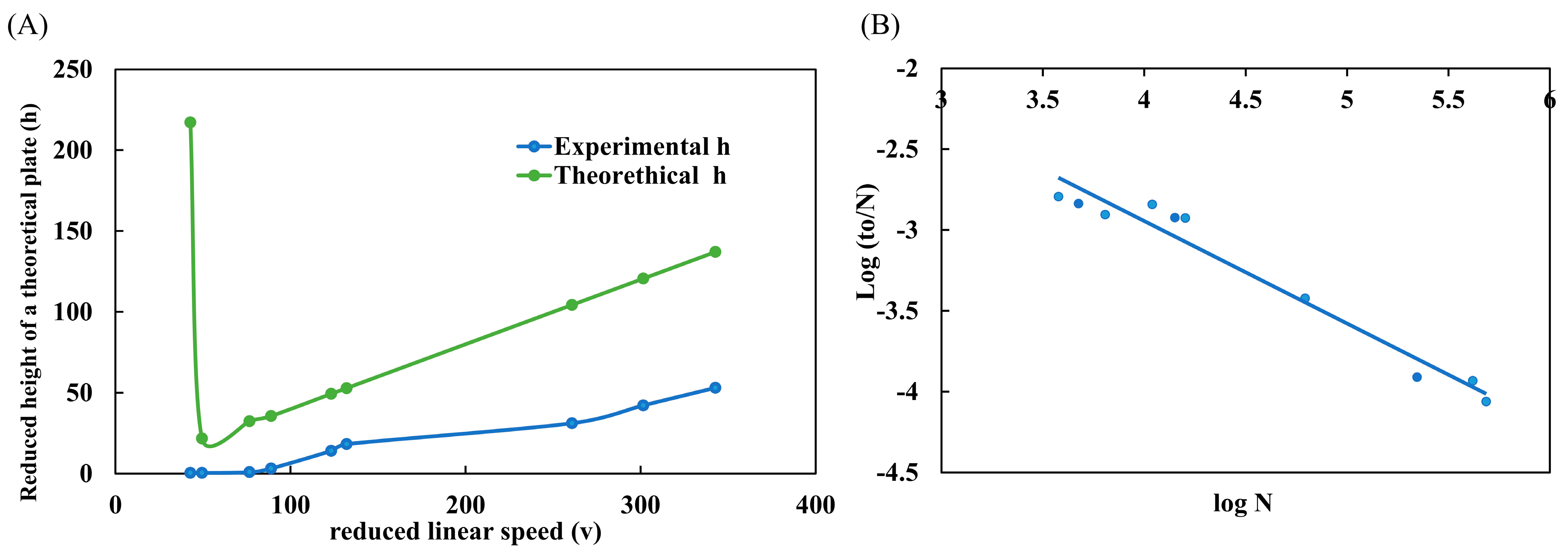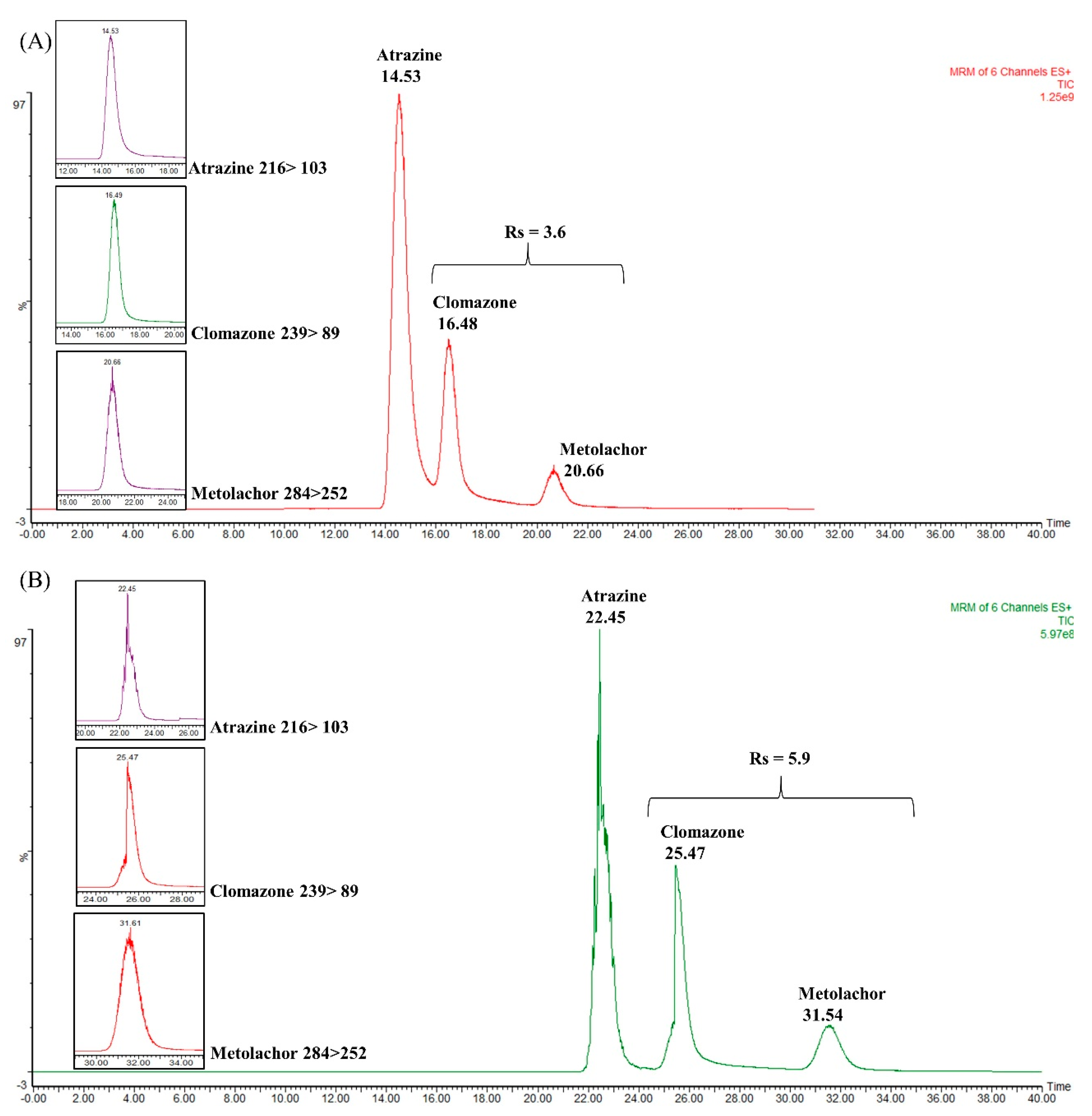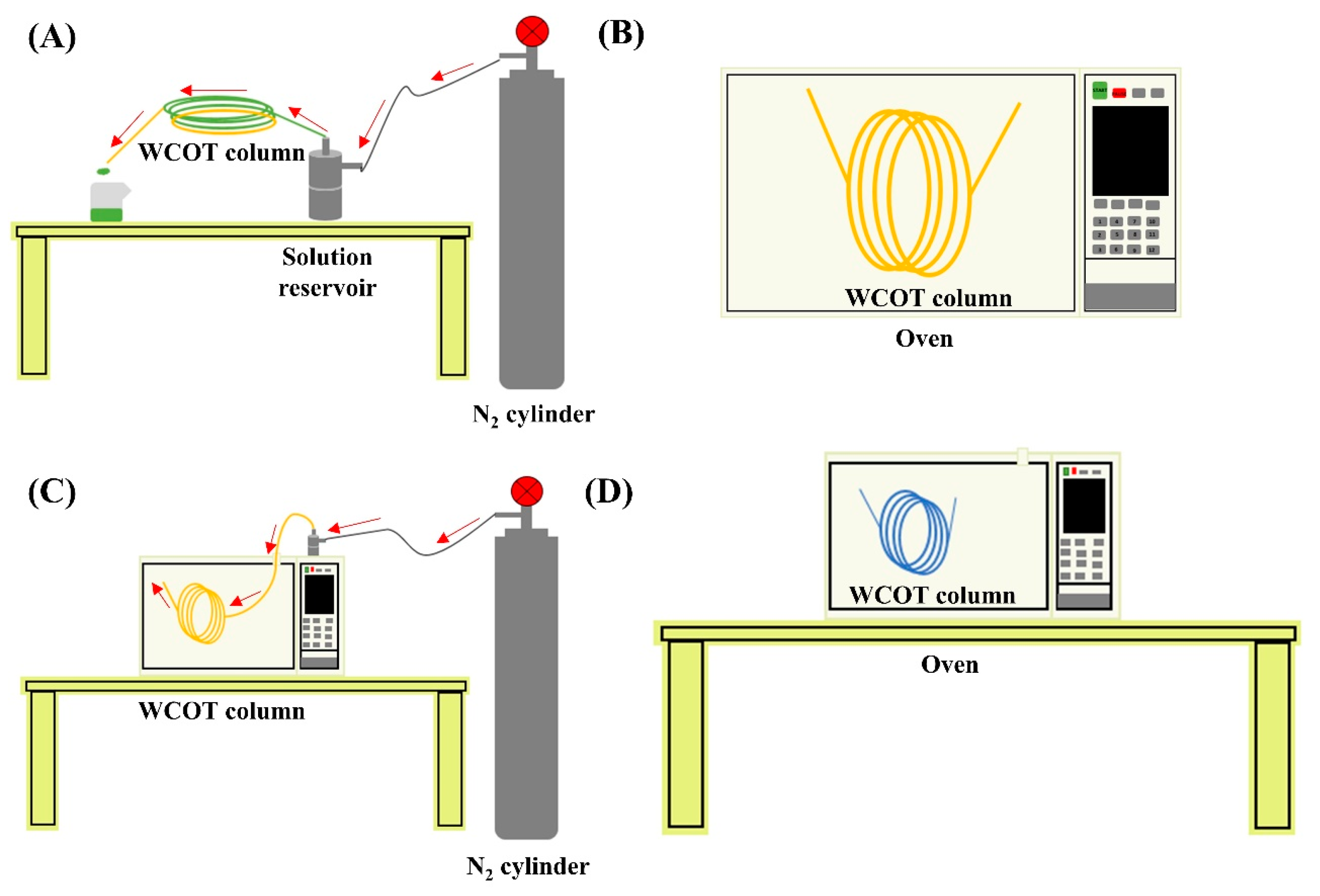Development of Wall-Coated Open Tubular Columns and Their Application to Nano Liquid Chromatography Coupled to Tandem Mass Spectrometry
Abstract
:1. Introduction
2. Results and Discussion
2.1. Preparation of WCOT Columns
2.2. Screening of Stationary Phases
2.3. Evaluating Parameters That Affect WCOT Columns
2.4. Performance Evaluation: Knox and Poppe Graphics
2.5. Coupling WCOT Column with a Trapping Column
3. Review of Similar Works
4. Materials and Methods
4.1. Analytical Standards and Reagents
4.2. Chromatographic Apparatus and Analytical Conditions
4.3. Preparation of WCOT Columns
4.3.1. Tube Pretreatment
4.3.2. Silanization
4.3.3. Stationary Phase Coating
4.3.4. Film Immobilization
4.4. Screening of Stationary Phases
4.5. Evaluating Parameters That Affect WCOT Columns
4.5.1. WCOT Column Length
4.5.2. WCOT Column Inner Diameter
4.5.3. Stationary Phase Mass in the Coating
4.5.4. Optimum Flow Rate of the Mobile Phase
4.5.5. Optimum Injection Volume
4.5.6. Coupling WCOT Column with a Trapping Column
5. Conclusions
Supplementary Materials
Author Contributions
Funding
Institutional Review Board Statement
Informed Consent Statement
Data Availability Statement
Conflicts of Interest
Sample Availability
References
- Mejía-Carmona, K.; Soares da Silva Burato, J.; Borsatto, J.V.B.; de Toffoli, A.L.; Lanças, F.M. Miniaturization of Liquid Chromatography Coupled to Mass Spectrometry. TrAC Trends Anal. Chem. 2020, 122, 115735. [Google Scholar] [CrossRef]
- Nota, G.; Marino, G.; Buonocore, V.; Ballio, A. Liquid-Solid Chromatography with Open Glass Capillary Columns Separation of 1-Dimethylaminonaphthalene-5-Sulphonyl Amino Acids. J. Chromatogr. A 1970, 46, 103–106. [Google Scholar] [CrossRef]
- Guiochon, G.; Claude, L.G. Chapter 8 Methodology Open Tubular Columns. In Journal of Chromatography Library; Elsevier: Amsterdam, The Netherlands, 1988; Volume 42, pp. 247–317. [Google Scholar]
- Ettre, L.S. MJE Golay and the Invention of Open-Tubular (Capillary) Columns. J. High Resolut. Chromatogr. 1987, 10, 221–230. [Google Scholar] [CrossRef]
- Tsuda, T.; Hibi, K.; Nakanishi, T.; Takeuchi, T.; Ishii, D. Studies of Open-Tubular Micro-Capillary Liquid Chromatography. J. Chromatogr. A 1978, 158, 227–232. [Google Scholar] [CrossRef]
- Yang, F.J. Fused Silica Open Tubular Column for Liquid Chromatography. J. High Resolut. Chromatogr. 1980, 3, 589–590. [Google Scholar] [CrossRef]
- Göhlin, K.; Larsson, M. Narrow (5-50-μm i.d.) Open Tubular Columns in Liquid Chromatography Using Immobilized Polymethyloctadecylsiloxane as Stationary Phase. J. Microcolumn Sep. 1991, 3, 547–556. [Google Scholar] [CrossRef]
- Göhlin, K.; Larsson, M. Study of Polyorganosiloxanes (Native and Solvent Swollen) for the Preparation of Narrow (5-15 Μm I.D.) and Long (1–6 m) Open Tubular Columns in Reversed-Phase Liquid Chromatography. J. Chromatogr. A 1993, 645, 41–56. [Google Scholar] [CrossRef]
- Folestad, S.; Larsson, M. Swollen Polysiloxanes as Stationary Phases in Reversed-Phase Open-Tubular Column Liquid Chromatography. J. Chromatogr. A 1987, 394, 455–464. [Google Scholar] [CrossRef]
- Takeuchi, T.; Ishii, D. Chemically Bonded Octadecylsilane and Polyimine Stationary Phases for Open-Tubular Microcapillary Liquid Chromatography. J. Chromatogr. A 1983, 279, 439–448. [Google Scholar] [CrossRef]
- Hibi, K.; Ishii, D.; Fujishima, I.; Takeuchi, T.; Nakanishi, T. Studies of Open Tubular Micro Capillary Liquid Chromatography. 1. The Development of Open Tubular Micro Capillary Liquid Chromatography. J. High Resolut. Chromatogr. 1978, 1, 21–27. [Google Scholar] [CrossRef]
- Forster, S.; Kolmar, H.; Altmaier, S. Synthesis and Characterization of New Generation Open Tubular Silica Capillaries for Liquid Chromatography. J. Chromatogr. A 2012, 1265, 88–94. [Google Scholar] [CrossRef]
- Knox, J.H.; Gilbert, M.T. Kinetic Optimization of Straight Open-Tubular Liquid Chromatography. J. Chromatogr. A 1979, 186, 405–418. [Google Scholar] [CrossRef]
- Saito, Y.; Jinno, K.; Greibrokk, T. Capillary Columns in Liquid Chromatography: Between Conventional Columns and Microchips. J. Sep. Sci. 2004, 27, 1379–1390. [Google Scholar] [CrossRef] [PubMed]
- Jorgenson, J.W.; Guthrie, E.J. Liquid Chromatography in Open-Tubular Columns: Theory of Column Optimization with Limited Pressure and Analysis Time, and Fabrication of Chemically Bonded Reversed-Phase Columns on Etched Borosilicate Glass Capillaries. J. Chromatogr. A 1983, 255, 335–348. [Google Scholar] [CrossRef]
- Xiang, P.; Yang, Y.; Zhao, Z.; Chen, M.; Liu, S. Ultrafast Gradient Separation with Narrow Open Tubular Liquid Chromatography. Anal. Chem. 2019, 91, 10738–10743. [Google Scholar] [CrossRef]
- Farré-Rius, F.; Henniker, J.; Guiochon, G. Wetting Phenomena in Gas Chromatography Capillary Columns. Nature 1962, 196, 63–64. [Google Scholar] [CrossRef]
- Grob, K. Making and Manipulating Capillary Columns for Gas Chromatography, 1st ed.; Dr. Alfred Hüthig Verlag: New York, NY, USA, 1986; Volume 1, ISBN 3778513125. [Google Scholar]
- Rajkó, R.; Körtvélyesi, T.; Sebők-Nagy, K.; Görgényi, M. Theoretical Characterization of McReynolds’ Constants. Anal. Chim. Acta 2005, 554, 163–171. [Google Scholar] [CrossRef]
- McReynolds, W.O. Characterization of Some Liquid Phases. J. Chromatogr. Sci. 1970, 8, 685–691. [Google Scholar] [CrossRef]
- Parris, N.A. Chapter 3 The Chromatographic Support and Column. In Journal of Chromatography Library; Elsevier: Amsterdam, The Netherlands, 1976; Volume 5, pp. 19–41. [Google Scholar]
- Forster, S.; Kolmar, H.; Altmaier, S. Performance Evaluation of Thick Film Open Tubular Silica Capillary by Reversed Phase Liquid Chromatography. J. Chromatogr. A 2013, 1283, 110–115. [Google Scholar] [CrossRef]
- Gritti, F.; Guiochon, G. The Current Revolution in Column Technology: How It Began, Where Is It Going? J. Chromatogr. A 2012, 1228, 2–19. [Google Scholar] [CrossRef]
- Poppe, H. Some Reflections on Speed and Efficiency of Modern Chromatographic Methods. J. Chromatogr. A 1997, 778, 3–21. [Google Scholar] [CrossRef]






| n° | Composition | Stationary Phase | McReynolds Constants |
|---|---|---|---|
| 1 | 5% phenyl 95% DMPS | OV-73 | 334 |
| 2 | 50% phenyl 50% DMPS | OV-17 | 884 |
| 3 | 50% trifluoropropyl 50% DMPS | OV-210 | 1520 |
| 4 | 25% cyano 25% phenyl 50% DMPS | OV-225 | 1867 |
| 5 | 100% cyanopropyl DMPS | OV-275 | 3652 |
| DMPS: dimethylpolysiloxane |
| n° | Stationary Phase | Column Dimension | Analytes | Instrument | Flow Rate | Time | Elution | Year |
|---|---|---|---|---|---|---|---|---|
| 1 | ODS * | 3.84 m × 60 μm | Benzene, Naphthalene, Biphenyl | LC-UV | 2.2 μL/min | 20 min | 25:75 ACN/H2O | 1978 |
| 2 | ODS | 20.80 m × 56 μm | Benzene, Biphenyl, and HPAs | LC-UV | 1.0 μL/min | 90 min | 40:60 ACN/H2O | 1978 |
| 3 | ODS | 6.00 m × 100 μm | Resorcinol, Naphthalene, Anthracene | LC-UV | 1.1 μL/min | 90 min | 40:60 ACN/H2O | 1980 |
| 4 | ODS | 5.30 m × 38 μm | Indole-3-acetic acid | LC-UV | 1.1 μL/min | 12 min | 10:90 ACN/acetic acid aqueous solution | 1983 |
| 5 | ODS | 22.00 m × 31 μm | HPAs | LC-UV | 0.52 μL/min | 120 min | ramp from 40 to 70% ACN | 1983 |
| 6 | PS-255 * | 2.08 m × 11.6 μm | Anthracene derivatives | LC-UV | 0.022 μL/min | 40 min | 40:60 ACN/H2O | 1987 |
| 7 | PS-255 | 1.93 m × 11.3 μm | Anthracene derivatives | LC-UV | not reported | 2 min | 70: 30 ACN/H2O | 1987 |
| 8 | PMSC18 * | 1.44 m × 5.8 μm | Anthracene derivatives | LC-UV | 0.013 μL/min | 4 min | 50:50 ACN/phosphate aqueous solution | 1991 |
| 9 | PMSC18 | 5.80 m × 6.3 μm | Anthracene derivatives | LC-UV | 0.0046 μL/min | 130 min | 50:50 ACN/H2O | 1993 |
| 10 | ODS | 0.80 m × 2.0 μm | Glycine, Isoleucine, Leucine | LC-UV | 18 μL/min | 7 min | 20:80 ACN/ammonium aqueous solution | 2019 |
| 11 | OV-210 | 5.00 m × 25 μm | Atrazine, Clomazone, Metolachlor | nanoLC-ESI-MS/MS | 0.30 μL/min | 60 min | Gradient ACN/H2O | This work |
| Analyte | MM | log P | Precursor Ion (m/z) | Product Ion (m/z) | Dwell (s) | Cone (V) | Collision Energy (V) |
|---|---|---|---|---|---|---|---|
| Atrazine | 215.68 | 2.61 | 216.06 | 96.018 | 0.512 | 22 | 20 |
| 103.95 | 0.512 | 22 | 26 | ||||
| Clomazone | 239.70 | 2.50 | 239.93 | 89.19 | 0.152 | 50 | 46 |
| 124.96 | 0.152 | 50 | 16 | ||||
| Metolachor | 283.79 | 3.13 | 284.00 | 176.00 | 0.152 | 20 | 30 |
| 252.00 | 0.152 | 20 | 20 | ||||
| Oxyfluorfen | 361.70 | 4.73 | 362.00 | 140.00 | 0.152 | 30 | 50 |
| 2370.00 | 0.152 | 20 | 20 |
Disclaimer/Publisher’s Note: The statements, opinions and data contained in all publications are solely those of the individual author(s) and contributor(s) and not of MDPI and/or the editor(s). MDPI and/or the editor(s) disclaim responsibility for any injury to people or property resulting from any ideas, methods, instructions or products referred to in the content. |
© 2023 by the authors. Licensee MDPI, Basel, Switzerland. This article is an open access article distributed under the terms and conditions of the Creative Commons Attribution (CC BY) license (https://creativecommons.org/licenses/by/4.0/).
Share and Cite
Santos, N.G.P.; Medina, D.A.V.; Lanças, F.M. Development of Wall-Coated Open Tubular Columns and Their Application to Nano Liquid Chromatography Coupled to Tandem Mass Spectrometry. Molecules 2023, 28, 5103. https://doi.org/10.3390/molecules28135103
Santos NGP, Medina DAV, Lanças FM. Development of Wall-Coated Open Tubular Columns and Their Application to Nano Liquid Chromatography Coupled to Tandem Mass Spectrometry. Molecules. 2023; 28(13):5103. https://doi.org/10.3390/molecules28135103
Chicago/Turabian StyleSantos, Natalia G. P., Deyber A. V. Medina, and Fernando M. Lanças. 2023. "Development of Wall-Coated Open Tubular Columns and Their Application to Nano Liquid Chromatography Coupled to Tandem Mass Spectrometry" Molecules 28, no. 13: 5103. https://doi.org/10.3390/molecules28135103







